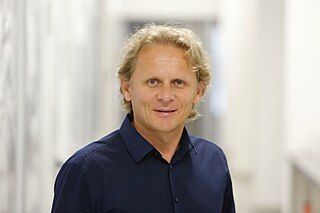
The University of Jena, officially the Friedrich Schiller University Jena, is a public research university located in Jena, Thuringia, Germany.

Goethe University is a university located in Frankfurt am Main, Germany. It was founded in 1914 as a citizens' university, which means it was founded and funded by the wealthy and active liberal citizenry of Frankfurt. The original name was Universität Frankfurt am Main. In 1932, the university's name was extended in honour of one of the most famous native sons of Frankfurt, the poet, philosopher and writer/dramatist Johann Wolfgang von Goethe. The university currently has around 45,000 students, distributed across four major campuses within the city.

The Molecular Foundry is a nanoscience user facility located at the Lawrence Berkeley National Laboratory in Berkeley, California, and is one of five Nanoscale Science Research Centers sponsored by the United States Department of Energy.

Thomas Eugene Everhart FREng is an American educator and physicist. His area of expertise is the physics of electron beams. Together with Richard F. M. Thornley he designed the Everhart–Thornley detector. These detectors are still in use in scanning electron microscopes, even though the first such detector was made available as early as 1956.

The European Molecular Biology Laboratory (EMBL) is a molecular biology research institution supported by 27 member states, two prospect states, and one associate member state. EMBL was created in 1974 and is an intergovernmental organisation funded by public research money from its member states. Research at EMBL is conducted by approximately 85 independent groups covering the spectrum of molecular biology. The list of independent groups at EMBL can be found at www.embl.org. The Laboratory operates from six sites: the main laboratory in Heidelberg, and sites in Hinxton, Grenoble (France), Hamburg (Germany), Rome (Italy) and Barcelona (Spain). EMBL groups and laboratories perform basic research in molecular biology and molecular medicine as well as train scientists, students, and visitors. The organization aids in the development of services, new instruments and methods, and technology in its member states. Israel is the only full member state located outside Europe.

The Beckman Institute for Advanced Science and Technology is a unit of the University of Illinois Urbana-Champaign dedicated to interdisciplinary research. A gift from scientist, businessman, and philanthropist Arnold O. Beckman (1900–2004) and his wife Mabel (1900–1989) led to the building of the Institute which opened in 1989. It is one of five institutions which receive support from the Arnold and Mabel Beckman Foundation on an ongoing basis. Current research at Beckman involves the areas of molecular engineering, intelligent systems, and imaging science. Researchers in these areas work across traditional academic boundaries in scientific projects that can lead to the development of real-world applications in medicine, industry, electronics, and human health across the lifespan.
Horst Stöcker is a German theoretical physicist and Judah M. Eisenberg Professor Laureatus at J.W. Goethe - Universität, Frankfurt

The Frankfurt Institute for Advanced Studies (FIAS) is a private-public institution for basic theoretical research in various areas of science focusing on interdisciplinary research. It is located in Frankfurt am Main, Germany, at its own home at the Frankfurt-Riedberg campus of the Goethe University. It was founded in 2003.

The Max Planck Institute of Biophysics is located in Frankfurt, Germany. It was founded as the Kaiser Wilhelm Institute of Biophysics in 1937, and moved into a new building in 2003. It is an institute of the Max Planck Society.

The Fritz Haber Institute of the Max Planck Society (FHI) is a science research institute located at the heart of the academic district of Dahlem, in Berlin, Germany.

National Institute for Materials Science is an Independent Administrative Institution and one of the largest scientific research centers in Japan.
The Nencki Institute of Experimental Biology is a Polish scientific research organization and a part of Polish Academy of Sciences headquartered in Warsaw, Poland. Founded in 1918, it is a leading institution in the country in the field of neurobiology, molecular biology, and biochemistry.
Knut W. Urban is a German physicist. He has been the Director of the Institute of Microstructure Research at Forschungszentrum Jülich from 1987 to 2010.

The House of Finance is an interdisciplinary research and teaching institute for law and economics at Goethe University in Frankfurt am Main, Germany. Its mission is to evolve into a leading European and, ultimately, international center for financial and partly legal research.

Ivan Đikić is a Croatian-German molecular biologist who is the Director of the Institute of Biochemistry II at Goethe University Frankfurt.

Birgitta Wolff is a German economist and politician of the Christian Democratic Union (CDU). She served as minister of education and culture and as minister of research and economy in the state government of Saxony-Anhalt from 2010 to 2013, and as president of the Goethe University of Frankfurt from 2015 to 2020.

Anatoly V. Zayats FInstP, FOSA, FSPIE, FRSC is a British experimental physicist of Ukrainian origin known for his work in nanophotonics, plasmonics, metamaterials and applied nanotechnology. He is currently a Chair in Experimental Physics and the head of the Photonics & Nanotechnology Group at King's College London. He is a co-director of the London Centre for Nanotechnology and the London Institute for Advanced Light Technologies

Bettina Stark-Watzinger is a German economist and politician of the Free Democratic Party (FDP) who has been serving as Minister of Education and Research in Chancellor Olaf Scholz's cabinet since 2021. She has been a member of the Bundestag from the state of Hesse since 2017. Since 2021, she has been the chairwoman of the FDP in Hesse.
Michael Meyer-Hermann is a professor at the Technical University of Braunschweig and head of the department of Systems Immunology at the Helmholtz Centre for Infection Research.
Enrico Schleiff is a German biologist and physicist, and the president of the Goethe University Frankfurt, serving since 1 January 2021.














